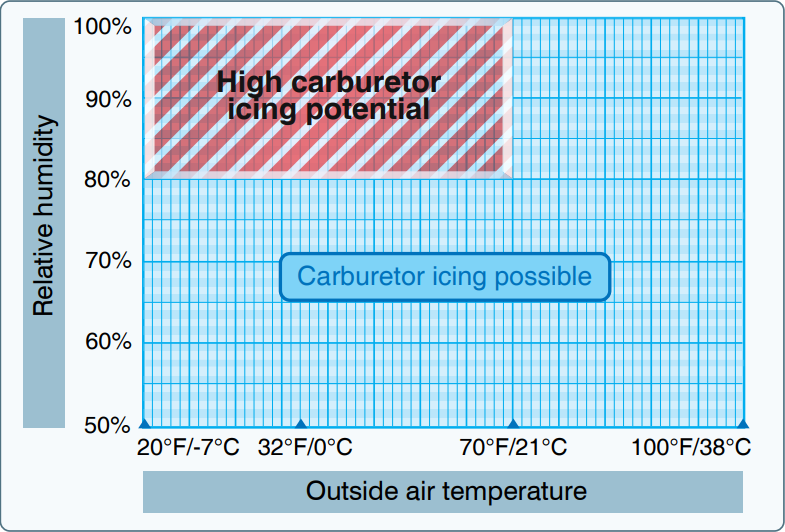Carburetor ice can form even on warm summer days, silently robbing engine power and potentially causing engine failure. This phenomenon occurs when moisture in the air freezes inside the carburetor, restricting airflow and fuel mixture. Understanding when and why carburetor ice forms—and how to prevent it—is essential knowledge for every pilot flying carbureted aircraft engines.
Quick Answer: Carburetor ice forms when moist air passes through the carburetor venturi, causing temperature drops of 60-70°F due to fuel vaporization and pressure reduction. Ice forms most readily between 20°F and 70°F outside air temperature with visible moisture or high humidity. Apply carburetor heat at the first sign of roughness or RPM drop. Prevention includes using full carburetor heat during descents and partial heat in cruise when conditions favor icing.
How Carburetor Ice Forms
The carburetor venturi accelerates airflow, creating a pressure drop per Bernoulli’s principle. This pressure reduction causes temperature to drop 40-50°F. Simultaneously, fuel vaporizing in the carburetor absorbs heat, dropping temperature another 10-20°F. Combined, these effects reduce carburetor temperature 60-70°F below outside air temperature.
When the carburetor temperature drops below freezing (32°F), moisture in the air freezes on metal surfaces. Ice builds up on the throttle valve and venturi walls. The ice restricts airflow, leaning the fuel mixture and reducing power. In severe cases, the engine may quit entirely if ice completely blocks the carburetor throat.
Conditions That Favor Icing
Carburetor ice forms most readily when outside air temperature is between 20°F and 70°F with high humidity. The danger zone is 40-60°F with visible moisture—clouds, rain, or fog. However, ice can form in clear air with high relative humidity. Even at 80°F outside temperature, carburetor ice is possible with sufficient moisture.
Low power settings increase icing risk. The partially closed throttle creates greater pressure drop and airflow restriction where ice accumulates. Prolonged descents with idle power create ideal icing conditions. High humidity at sea level increases risk compared to dry mountain air. Coastal regions and areas near water bodies see more carburetor ice incidents.
Recognizing Carburetor Ice Symptoms
The first sign is usually a gradual RPM decrease in fixed-pitch propeller aircraft. Manifold pressure drops in constant-speed propeller installations. The engine runs rough as the mixture becomes increasingly lean. Excessive carburetor ice causes significant power loss or complete engine stoppage.
Unlike mechanical engine problems, carburetor ice develops gradually over several minutes. The RPM decrease is smooth and continuous rather than sudden. No mechanical roughness or vibration occurs initially—the engine simply loses power. In fuel-injected aircraft, these symptoms don’t occur because fuel injection systems don’t have carburetors that can ice up.
Using Carburetor Heat Effectively
Carburetor heat provides hot air from a shroud around the exhaust system to the carburetor. Pulling the carburetor heat control routes air through the heated shroud instead of the normal cold air intake. The hot air raises carburetor temperature above freezing, melting existing ice and preventing new ice formation.
When ice is present, applying carburetor heat initially causes RPM to drop further as ice melts and water passes through the engine. After 10-30 seconds, RPM increases as ice clears and normal airflow resumes. This temporary RPM decrease confirms ice was present. Apply full carburetor heat at the first indication of power loss or rough running.
Preventive Use of Carburetor Heat
Use full carburetor heat during extended descents at reduced power. The low power setting and high humidity in clouds create prime icing conditions. Apply heat before ice forms rather than waiting for symptoms. In cruise flight during conditions conducive to icing, periodic applications of carburetor heat prevent ice accumulation.
Some pilots use partial carburetor heat continuously in cruise during marginal icing conditions. This keeps carburetor temperature above freezing without the power loss associated with full heat. However, partial heat may position carburetor temperature in the icing range—full hot or full cold is generally safer. Check your aircraft’s POH for specific recommendations.
Carburetor Heat and Performance
Carburetor heat reduces engine power by 10-15% because hot air is less dense than cold air. Heated air bypasses the air filter, allowing unfiltered air into the engine. Never use carburetor heat for takeoff unless ice is present—the power loss could prevent adequate climb performance. Carburetor heat air is not filtered, potentially allowing dirt into the engine during ground operations.
At high altitude airports, carburetor heat may increase performance slightly because the heated air improves fuel vaporization. In go-around situations, push carburetor heat to cold immediately to restore full power. Remember that using carburetor heat enriches the mixture—lean as necessary when using extended carburetor heat to prevent plug fouling.
Fuel Injection vs Carburetor Systems
Fuel-injected engines eliminate carburetor ice entirely because they don’t use carburetors. Fuel injection delivers fuel directly to each cylinder intake port. However, fuel-injected engines can experience induction ice on the air intake filter or throttle body. This ice forms differently and requires alternate air systems rather than carburetor heat.
Aircraft with fuel injection have alternate air controls instead of carburetor heat. The alternate air system provides unfiltered air if ice blocks the normal intake. Fuel injection provides more precise fuel metering and eliminates carburetor icing concerns, though the systems cost more initially and require specialized maintenance knowledge.
Emergency Procedures for Severe Icing
If the engine quits from carburetor ice, immediately apply full carburetor heat and enrichen the mixture. Maintain altitude if possible while the engine restarts. The engine may take 30-60 seconds to restart as ice melts. Consider switching fuel tanks to ensure fuel flow isn’t restricted. Turn on boost pumps if equipped.
In severe cases with complete power loss, prepare for an off-airport landing while attempting restart procedures. Maintain best glide speed and select a suitable landing area. Keep attempting restart with full carburetor heat—engines often restart once sufficient ice melts. Avoid the temptation to cycle carburetor heat on and off; leave it full hot until the engine restarts and runs smoothly. Report the incident to help other pilots avoid similar conditions.
Join the Aircraft Insider Community
Get exclusive backcountry flying tips, aircraft reviews, and Western aviation destinations delivered to your inbox.
✈️ No spam, ever. Unsubscribe anytime. Privacy respected.




Leave a Reply